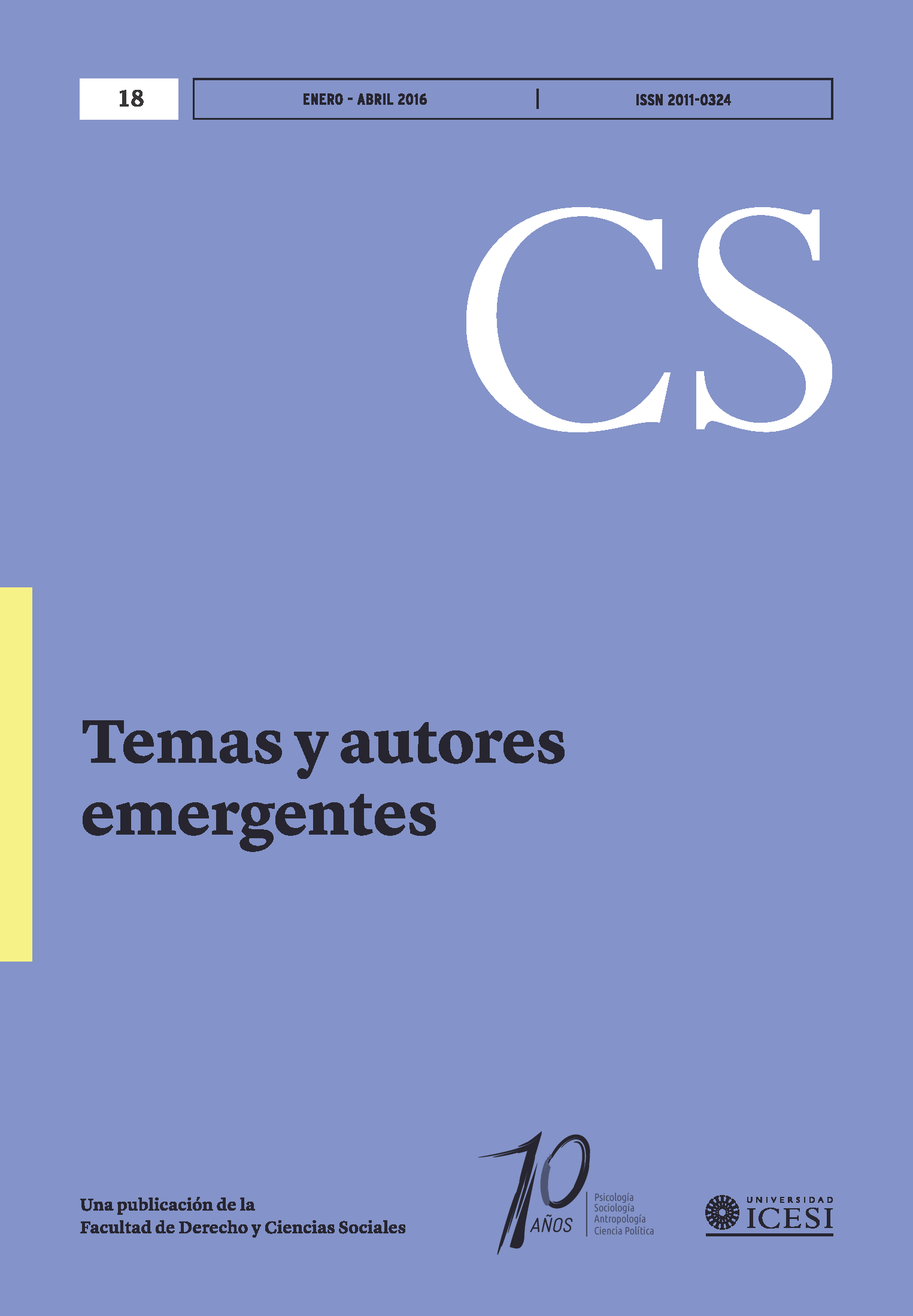Generals Aspects of an Orality Model in Icesi University
DOI:
https://doi.org/10.18046/recs.i18.2057Keywords:
Orality, Prosaic, Rhetoric, Dramatic, Signification, SenseAbstract
This research report presents the results gathered during the stages of inquiry, compilation, and proposal of an orality model unique to Icesi University. The document is divided into five sections that make use of the Aristotelean rhetorical model: 1. Inventio: summarizes the process of establishing the need of an oral expression model for the Icesi university, including early stage research. 2. Dispositio: reviews the steps of the proposed model. 3. Elocutio: presents the theoretical background for the model. 4. Actio: a detailed characterization of the real world performance of the model. 5. Mneme: Conclusions.Downloads
References
Aristóteles . (2005). El arte de la retórica. Trad. Ignacio Granero. Buenos Aires, Argentina: AUDEBA.
Bañuelos, J. & Mata, F. (2014). Fotografía y dispositivos móviles: escenarios de un nuevo paradigma visual. Monterrey, México: Instituto tecnológico y de estudios superiores.
Bourdieu, P. (2001). ¿Qué significa hablar? Madrid: Akal.
Bunce, M. (2014). International news and the image of Africa: new storytellers, new narratives? En J. Gallagher, The Image of Africa. Manchester: Manchester University Press.
Donovan, Jeremy (2012). Método TED para hablar en público. Barcelona: Ariel.
Gordillo, T. (2010). Reseña al libro Storytelling. La máquina de fabricar y formatear mentes. Revista Comunicación, 89-93.
Habermas, J. (1997). Teoría de la acción comunicativa, Vol. 1: Racionalidad de la acción y racionalidad social. Madrid: Taurus.
Instituto Cervantes . (2008). Saber hablar. Madrid: Aguilar.
Lienhard, M. (1992). La voz y su huella. Lima: Horizonte.
Mandoki, K. (2006a). Estética cotidiana y juegos de la cultura: Prosaica l. México: Siglo Veintiuno.
Mandoki, K. (2006b). Prácticas estéticas e identidades sociales: Prosaica II. México: Siglo Veintiuno.
McEntee, E. (1996). Comunicación oral para el liderazgo en el mundo moderno. México: McGraw-Hill.
MIT Lab Media . (s.f.). About. Recuperado el 8 de Marzo de 2014, de sitio web del mit Lab Media: http://www.media.mit.edu/about
MIT Open Course Ware. (11 de Octubre de 2005). About. Recuperado el 18 de Marzo de 2014, de sitio web del canal de videos del mit Open Course Ware: https://www.youtube.com/user/MIT/about
Nieto Collazos, G. E. (2015). Cómo hacer diapositivas para sus presentaciones. Santiago de Cali: Universidad Icesi.
Nieva Fenoll, J. (Septiembre - diciembre de 2010). Los problemas de la oralidad. Revista do Ministério Público do RS. (67), 237-257.
Ong, W. (1997). Oralidad y escritura. Tecnologías de la palabra. México D.F.: Fondo de Cultura Económica.
Organización Creative Commons Colombia . (22 de Agosto de 2006). ¿Qué es creative commons? Recuperado el 8 de Julio de 2014, de sitio web de la Organización Creative Commons Colombia: http://co.creativecommons.org/?page_id=672
Oviedo Acevedo, T. (2002). Abra la boca. Santiago de Cali: Universidad Icesi, Facultad de Derecho y Ciencias Sociales.
Oxford Talks. (s.f.). Introducción. Recuperado el 12 de Marzo de 2014, de sitio web de Oxford Talks: http://talks.ox.ac.uk/document/Introduction
Poyatos, Fernando . (1970). Paralingüística y kinésica: para una teoría del sistema comunicativo en el hablante español. En Magis, C., editor, Actas del Tercer Congreso Internacional de Hispanistas. México: El Colegio de México
Poyatos, F. (1994). La comunicación no verbal. Madrid: Istmo.
Ricoeur, P. (1996). Tiempo y narración. México D.F.: Siglo XXI.
Salmon, C. (2008). Storytelling, la máquina de fabricar historias y formatear las mentes. Barcelona: Atalaya.
Seminario de oralidad . (2014). Cuaderno de apuntes del Seminario de Oralidad. Cali.
TED. (s.f.). Attending a TED Conference. Recuperado el 2 de Marzo de 2014, de sitio web de TED : http://www.ted.com/about/conferences
TED. (s.f.). Our mission: spread ideas. Recuperado el 2 de Marzo de 2014, de sitio web de TED Conferences: http://www.ted.com/about/our-organization
The Moth. (2007). About - What is The Moth? Obtenido de sitio web de The Moth: http://themoth.org/about
The President and Fellows of Harvard College. (2011). Description of Harvard Think Big. Recuperado el 16 de Marzo de 2014, de sitio web de Harvard Think Big en i Tunes: https://itunes.apple.com/us/itunes-u/harvard-thinks-big/id424040892?mt=10
Universidad Icesi. (Diciembre de 2013). Proyecto de Desarrollo Institucional al año 2022. Recuperado el 2014 de 8 de Julio, de sitio web de la Universidad Icesi: http://www.icesi.edu.co/mision_vision_futuro.php
University of Oxford. (2011). Acerca de nosotros. Recuperado el 25 de Marzo de 2014, de sitio web de University of Oxford Postcat: http://podcasts.ox.ac.uk/about
Vich, V. & Zavala, V. (2004). Oralidad y poder. Herramientas metodológicas. Buenos Aires: Norma.
Downloads
Published
Issue
Section
License
Copyright (c) 2016 Óscar Ortega García, James Rodríguez Calle, Maritza Montaño

This work is licensed under a Creative Commons Attribution-NonCommercial 4.0 International License.
© Reserved Copyright
Material in this publication may be reproduced without authorization, provided the title, author and institutional source is acknowledged.
The content published in Revista CS is distributed under the Creative Commons BY-NC 4.0 Attribution/Recognition-NonCommercial 4.0 International license.
You are free to:
Share — copy and redistribute the material in any medium or format.
Adapt — remix, transform, and build upon the material.
Under the following terms:
Attribution — You must give appropriate credit , provide a link to the license, and indicate if changes were made . You may do so in any reasonable manner, but not in any way that suggests the licensor endorses you or your use.
NonCommercial — You may not use the material for commercial purposes.












